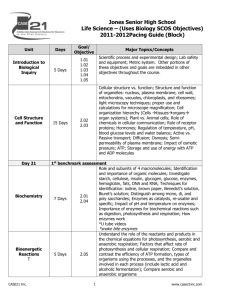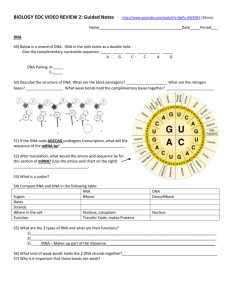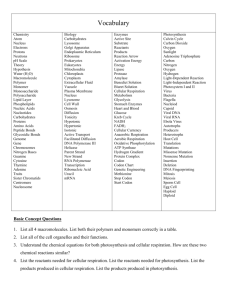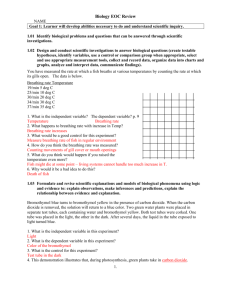Jones Senior High School BIOLOGY 2011
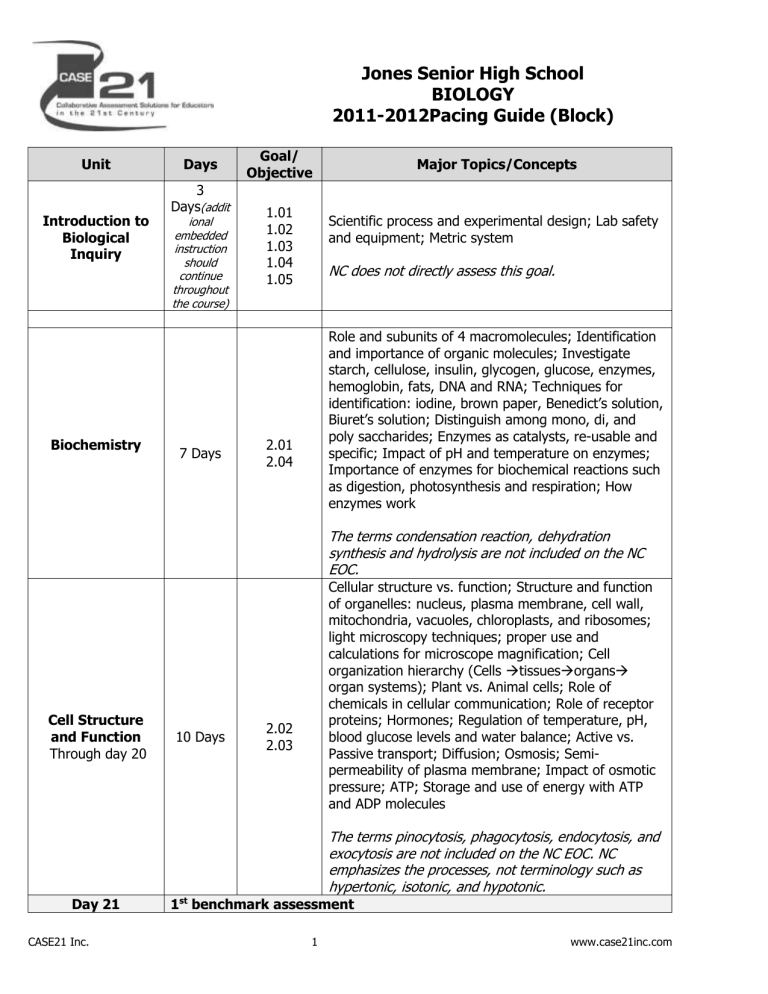
Unit
Introduction to
Biological
Inquiry
Biochemistry
Cell Structure and Function
Through day 20
Day 21 1 st
Days
3
Days (addit ional embedded instruction should continue throughout the course)
7 Days
10 Days
Goal/
Objective
1.01
1.02
1.03
1.04
1.05
2.01
2.04
2.02
2.03
Jones Senior High School
BIOLOGY
2011-2012Pacing Guide (Block)
NC does not directly assess this goal.
benchmark assessment
CASE21 Inc. 1
Major Topics/Concepts
Scientific process and experimental design; Lab safety and equipment; Metric system
Role and subunits of 4 macromolecules; Identification and importance of organic molecules; Investigate starch, cellulose, insulin, glycogen, glucose, enzymes, hemoglobin, fats, DNA and RNA; Techniques for identification: iodine, brown paper, Benedict’s solution,
Biuret’s solution; Distinguish among mono, di, and poly saccharides; Enzymes as catalysts, re-usable and specific; Impact of pH and temperature on enzymes;
Importance of enzymes for biochemical reactions such as digestion, photosynthesis and respiration; How enzymes work
The terms condensation reaction, dehydration synthesis and hydrolysis are not included on the NC
EOC.
Cellular structure vs. function; Structure and function of organelles: nucleus, plasma membrane, cell wall, mitochondria, vacuoles, chloroplasts, and ribosomes; light microscopy techniques; proper use and calculations for microscope magnification; Cell organization hierarchy (Cells tissues organs organ systems); Plant vs. Animal cells; Role of chemicals in cellular communication; Role of receptor proteins; Hormones; Regulation of temperature, pH, blood glucose levels and water balance; Active vs.
Passive transport; Diffusion; Osmosis; Semipermeability of plasma membrane; Impact of osmotic pressure; ATP; Storage and use of energy with ATP and ADP molecules
The terms pinocytosis, phagocytosis, endocytosis, and exocytosis are not included on the NC EOC. NC emphasizes the processes, not terminology such as hypertonic, isotonic, and hypotonic.
www.case21inc.com
Unit Days
Goal/
Objective
Major Topics/Concepts
Bioenergetic
Reactions
Thru day 26
Molecular
Genetics and
Biotechnology
Thru day 34
Meiosis and
Heredity
Thru day 53
6 Days
8 Days
19 Days
2.05
3.01
3.04
3.02
3.03
Understand the role of the reactants and products in the chemical equations for photosynthesis, aerobic and anaerobic respiration; Factors that affect rate of photosynthesis and cellular respiration; Compare and contrast the efficiency of ATP formation, types of organisms using the processes, and the organelles involved in each process (include lactic acid and alcoholic fermentation); Compare aerobic and anaerobic organisms
Glycolysis, Kreb’s Cycle, and Electron Transport Chain are not included on NC EOC. Students are not required to distinguish between light dependent and light independent parts of photosynthesis on NC EOC.
DNA vs. RNA structure; Complementary base pairing;
DNA nucleotide sequence codes for proteins; DNA replication’s role in ensuring exact copy of parental
DNA; Semi-conservative nature of replication; Mutation as a change in DNA; Replication in the cell cycle;
Importance of weak hydrogen bonds; Role of transcription in protein synthesis; Role of mRNA, tRNA and rRNA; Role of translation; Amino acids, peptide bonding and polypeptides; Use codon chart to determine amino acid coded by sequence of bases;
Cells within an organism have same DNA but vary due to expression of genes; Cell differentiation in multicellular organisms; Cells respond to environment by producing different types and amounts of protein;
Advantages and disadvantages of overproduction or underproduction of proteins; Relevance of human genome project including gene therapy; Gel electrophoresis; DNA fingerprinting; Applications of transgenic organisms in agriculture and industry including pharmaceutical; Implications and ethics of genomics and biotechnology including stem cell research andgenetically modified organisms
The NC EOC does not require students to know the steps of gel electrophoresis in order or in great detail.
Students should be able to interpret results and have a general understanding of what happens during the process.
Mitosis vs. Meiosis including replication and separation of DNA and cellular material, chromosome #, # of cell divisions, and # of cells produced in cell cycle;
Recognize diagrams of the processes and be able to arrange in order; Variation can result from crossing over, random assortment of chromosomes, gene
CASE21 Inc. 2 www.case21inc.com
Unit
Immune System
Function
Thru day 55
Day 58
Origin of Life and
Evolution
Thru day 63
Days
2 days
5 Days
Goal/
Objective
4.05
3.05
Major Topics/Concepts mutations, nondisjunction, and fertilization; Determine genotypes and phenotypes; Environment and genotype influence the expressed phenotype;
Importance of Mendel’s investigations and laws;
Interpret karyotypes; Dominant vs. Recessive alleles;
Intermediate patterns of inheritance: codominance or expression of both traits, and incomplete dominance or blending of traits; Autosomal inheritance patterns and characteristics of sickle cell anemia, cystic fibrosis and
Huntington’s disease; Multiple alleles: solve and interpret co-dominant crosses involving multiple alleles, blood types, use of blood types to determine paternity; Polygenic traits: control by more than one pair of genes, skin and hair color; Human sex determination; Solve crosses involving sex-linked traits like color-blindness and hemophilia; Understand why males are more likely to express a sex-linked trait;
Independent Assortment: importance of genes being on separate chromosomes as it relates to meiosis;
How the process of meiosis leads to independent assortment and greater genetic diversity; Test Cross: given certain phenotypes determine the genotype of an organism; Use pedigrees to identify the genotypes of individuals; Punnett squares: solve and interpret problems featuring monohybrid crosses; Determine parental genotypes based on offspring ratios
The NC EOC does not require students to memorize the names of the steps or the order of the step names for mitosis and meiosis.
Internal and external factors in health and disease: role of genetics and the environment in determining a specific response to disease, including sickle cell and malaria, PKU and diet, lung/mouth cancer and tobacco use, diabetes; Immune response including a basic understanding of: function and relationship of T-cells,
B-cells, antibodies/antigens, passive and active immunity and vaccines; Emphasize aspects of nutrition that contribute to optimal health and poor nutrition;
Focus on the life cycle, vector, symptoms, and treatments for the Malarial parasite (Plasmodium);
Environmental toxins such as Tobacco and UV radiation
(build in days for catchup = 3)
2 nd benchmark assessment
Development of the theory of evolution by natural selection; Biogenesis vs. Abiogenesis and supporting experiments; Origin and history of life including atmosphere hypotheses and experiments; Early
CASE21 Inc. 3 www.case21inc.com
Unit
Classification,
Taxonomy and
Microorganisms
Thru day 69
Days
6 Days
Goal/
Objective
4.01
4.02
(Protists)
4.03
Plant
Comparative
Anatomy and
Physiology
Thru day 74
5 Days
4.02
4.03
CASE21 Inc. 4
Major Topics/Concepts conditions impact on development of organisms
(anaerobic and prokaryotic); Evolution of eukaryotic and aerobic organisms; Fossil evidence (relative and absolute dating methods); Patterns in the fossil record and resulting inferences; Biochemical similarities as biochemical evidence of evolution; Shared anatomical structures as evidence; Mechanisms of evolution: how variations provide material for natural selection, role of geographic isolation in speciation, and importance of the environment in selecting adaptations; Applications: evolutionary selection of resistance to antibiotics and pesticides
The NC EOC excludes patterns in embryology and homologous and analogous vocabulary.
Changing nature of classification based on new knowledge generated by research on evolutionary relationships; History of classification system including the development of the seven level classification system (KPCOFGS) and binomial nomenclature; Basis of classification system: evolutionary phylogeny, DNA and biochemical analysis, embryology, morphology;
Review basic differences and similarities between prokaryotic and eukaryotic; Use dichotomous keys to identify organisms;
For the eukaryotic kingdoms compare: Cellular structures, Unicellular vs. Multicellular, Methods of making/getting food and breaking down food to get energy, and Reproduction; Focus on structural adaptations; Essential life functions of unicellular protists;
Structure of viruses, mutation of viruses and other microorganisms, and a variety of disease causing agents (viruses, bacteria) including:
HIV
Influenza
Smallpox
Streptococcus
Students should understand the changing nature of classification systems due to new knowledge.Currently, the 3 Domains with 6-7 kingdoms system is the predominant thinking.
Compare and contrast how plants accomplish the essential life functions focusing on physiology rather than on the names of parts.
Transport—howplants get what they need to cells
Excretion—balancefluids (pH, salt concentration,
www.case21inc.com
Unit
Ecology
Thru day 82
Animal
Comparative
Anatomy and
Physiology and
Adaptive
Behaviors
Thru day 85
Days
8 Days
3 Days
Goal/
Objective
5.01
5.02
5.03
4.02
4.03
4.04
Major Topics/Concepts water).
Regulation—hormones
Respiration—howplants exchange gases.
Nutrition—howplants absorb nutrients.
Synthesis—howorganisms build necessary molecules.
Reproduction—sexual vs. asexual, seeds, spores
Growth and development—growthfrom seed or spore.
Structural adaptations of non-vascular, vascular, gymnosperms and angiosperms- form to function;
Co-evolution: Emphasize the relationship between angiosperms and their pollinators
Symbiotic relationships; Predator/prey relationships and patterns; Field ecology techniques; Abiotic vs.
Biotic factors; Limiting factors influence on carrying capacity; Interpret population growth graphs;
Relationship of carbon cycle to photosynthesis and respiration; Analyze direction and efficiency of energy transfer within food chains, food webs and energy pyramids; Factors influencing birth and death rates;
Environmental impacts from human population size, density, and resource use to include acid rain, habitat destruction, and non-native species; Climatic changes due to greenhouse effect and natural processes such as volcanoes; Direct and indirect human impact on natural resources (deforestation, pesticide use and bioaccumulation research); Examples of sustainable practices and stewardship
Biomes and succession are not assessed on the NC
EOC.
Compare and contrast how animals (annelids, insects, amphibians & mammals) accomplish the essential life functions focusing on physiology rather than on the names of parts.
Transport—howanimals get what they need to cells and move wastes to organs of excretion
Excretion—howthey get rid of wastes; balance fluids
(pH, salt concentration, water).
Regulation—hormones, nervous system
Respiration—getoxygen from environment and release carbon dioxide
Nutrition—howthey break down and absorb foods
Synthesis—howthey build necessary molecules.
Reproduction—sexual vs. asexual, eggs, placental, types of fertilization
Growth and development—metamorphosis, development in egg or in uterus
CASE21 Inc. 5 www.case21inc.com
Unit
85 days
85-90
Days
Goal/
Objective
Major Topics/Concepts
Structural adaptations for feeding and mating—formto function;
Behaviors:
Innate behavior—Taxesand instincts, including: scratching behavior of dog (instinct), insects moving away from or toward light (taxis), migration, estivation, hibernation
Learned behavior—Imprinting, conditioning, and trial and error.
Social behavior—Communication, territorial defense, and courtship, including: communication within social structure using pheromones (ex: bees and ants), courtship dances, and territorial defense (ex: Fighting
Fish)
Review/Optional Comprehensive Benchmark
(covering all content days 1-80)
EOCTests
CASE21 Inc. 6 www.case21inc.com
